|
Some plants may be too generous with their seeds, like the aconitum, and may need cutting back to prevent inferior seedlings. Most though can be safely left to form and when covered in a gossamer of trembling cobwebs, weighed down with glistening dewdrops and catching the autumn light, the garden is a magical place. When winter finally arrives those spiders and other tiny beasties will make good use of any seed heads, using them as shelter, so leaving some of them intact not only looks lovely, it’s extremely eco-friendly too.
Grasses - the backbone
Grasses add profile and movement so they should always be planted in a light position preferably one that catches midday sun. As the days shorten the awns break up and become almost transparent, taking on a silvery patina as they age. They appear to shimmer, making a perfect foil for jewel-box, late-autumn flowers including asters and their close relative, the tall purple ironweed Vernonia arkansana 'Mammuth'. Garden worthy grasses don’t run or become invasive by self-seeding, but the trick is to pick the right grass for your situation. Then find some partners of a similar height, to avoid a little and large look.
Shorter Grasses with Perennials to Match
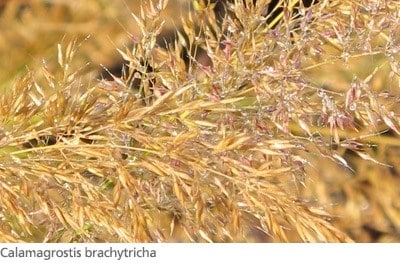
Calamagrostis brachytricha, a curtseying grass with feathery awns that open to light mauve before fading to silver-brown, is a seasonal highlight this month. Use it with shorter cool-toned purple and pink asters such as Aster × frikartii 'Mönch'. It doesn’t seed, keeps a tight clump, flowers now and it’s versatile too. It can tumble over a low stone wall with grace, or occupy a shadier niche - yet still flower well. The Korean feather grass, to use its common name, definitely looks best catching the light however.
 Good perennial partners could include Sedum ‘Purple Emperor’, a dark-leaved beauty with perfectly crimped foliage. Ruby-red, bee-pleasing flowers appear by August, but keep their colour for weeks, before forming dark-chocolate seed heads that endure until the end of the year. It’s one of the best sedums because it doesn’t divide and flop after a year or so: it stays in a neat clump and the foliage is dark from the moment it emerges. Good perennial partners could include Sedum ‘Purple Emperor’, a dark-leaved beauty with perfectly crimped foliage. Ruby-red, bee-pleasing flowers appear by August, but keep their colour for weeks, before forming dark-chocolate seed heads that endure until the end of the year. It’s one of the best sedums because it doesn’t divide and flop after a year or so: it stays in a neat clump and the foliage is dark from the moment it emerges.
A meatier sedum, with plump erect stems and large wavy-edged leaves in pigeon-breast grey is ‘Matrona’. This matronly sedum, like a middle-aged woman with a pinny and rolling pin, produces pearl-pink, bee-friendly flowers that are perfect with dusky pink diascias. Its strong stance is pleasing throughout winter. Both of these recent sedums were chance seedlings noticed by sharp-eyed nurserymen. ‘Matrona’ was spotted by Ewald Hugen of Freiburg in Germany and ‘Purple Emperor’ by Graham Gough in England. However did we manage without them!
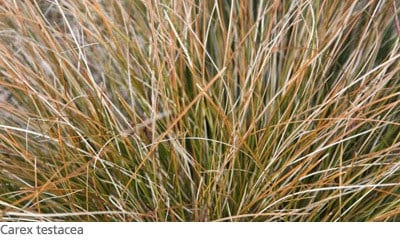
Shorter fine-tined grass-like plants don’t tend to produce showy flowers. Instead their leaves spiral round in the wind, constantly moving and twining through perennials as they go. The orange-toned Carex testacea has a year-long presence and it’s hardy. Stipa tenuissima produces tactile, hair-like strands in bright-green early in the year. These fade to harvest-gold and have earned it the common name of ponytail grass. Both grasses look wonderful in winter.
Taller Grasses to Gaze Through
Most taller grasses flower in the second half of summer. However Stipa gigantea is often in full swing by early May, with man-high stems that fountain straight out at an angle from low grey-green leaves. Known as the golden oat grass, the ten or so stems will shimmy and shake for nine months of the year - whether they’re rising above ornamental alliums in May or shivering in late-autumn winds. This is a grass to gaze through, as light and airy as honeycomb and exactly the same colour. Stipas resent division though. It usually sees them off.
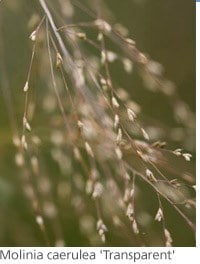 Tall molinias, including named varieties of Molinia caerulea. subsp. arundinacea, have flowers from July onwards held well above the foliage. Varieties vary in habit, but ‘Transparent’ is well-named for its awns that form fine beaded heads. In drier gardens these gradually turn to jet-black, although molinias thrive in all soils. Part of their charm is their habit of holding their flowers high on lots of straight stems and they happily do this cheek by jowl with tall perennials. The key word with these tall molinias is arundinacea, literally arundo-like, because this denotes a tall grass. Tall molinias, including named varieties of Molinia caerulea. subsp. arundinacea, have flowers from July onwards held well above the foliage. Varieties vary in habit, but ‘Transparent’ is well-named for its awns that form fine beaded heads. In drier gardens these gradually turn to jet-black, although molinias thrive in all soils. Part of their charm is their habit of holding their flowers high on lots of straight stems and they happily do this cheek by jowl with tall perennials. The key word with these tall molinias is arundinacea, literally arundo-like, because this denotes a tall grass.
Good partners might include the dark-red bobbles of Sanguisorba officinalis ‘Red Thunder’, a perennial that also looks like a grass from a distance. Or you might use the tall purple bergamot Monarda ‘Scorpion' as a partner. Bred by Piet Oudolf, this tall purple monarda has black-tinted bracts under the flowers and the square, resilient stems last into winter - an Oudolf priority. Like all monardas it pleases the bees.

The most upright grass of all, Calamagrostis x acutiflora ‘Karl Foerster’ forms a four-foot high russet sheath of stems in autumn. The flowers appear in June or July and the stems can snap at the nodes at this stage so find it a key position in a sheltered place and it will give you vertical presence for many months. It’s right at the top of most people’s best grasses, for it’s rocket-like, stem-packed silhouette is unique.
The grassy stars of autumn are named forms of Miscanthus sinensis, because they offer great diversity of form and a variety of colours in both foliage and flowerhead. This attracted early gardeners like Gertrude Jekyll and William Robinson over a hundred years ago and ‘Zebrinus’ (1877) was a Jekyll favourite, grown for its elegant shape and green foliage discretely banded in cream horizontal lines. The Japanese variety ‘Morning Light’ is a fine-tined vision of cream and white verticals, with small insignificant flowers. It is slow-growing and diminutive and it’s been grown for centuries in Japanese gardens as a foliage plant.
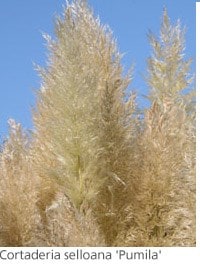 The most popular varieties are plumed though, and colour can vary from wine-red, to pink or silver. All age within four weeks to varied shades of silver and brown but the awns also vary in texture. ‘Gracillimus’ (1888), a heritage variety Jekyll would have known, is late to flower with finely cut reddish flowers held above a rounded mound of fine foliage. ‘Malepartus’ (a more-modern variety) flowers a full four weeks earlier and is similar in shape and form. Both are classics. Those north of the Watford Gap should opt for earlier flowering miscanthus, not the later arrivals, because they may not flower for you in cool summers. October always benefits from a pampas grass and Cortaderia selloana ‘Pumila’ is far too good for the front lawns of suburban bungalows. It’s a superb as a corner of the border plant, lighting up winter days. The most popular varieties are plumed though, and colour can vary from wine-red, to pink or silver. All age within four weeks to varied shades of silver and brown but the awns also vary in texture. ‘Gracillimus’ (1888), a heritage variety Jekyll would have known, is late to flower with finely cut reddish flowers held above a rounded mound of fine foliage. ‘Malepartus’ (a more-modern variety) flowers a full four weeks earlier and is similar in shape and form. Both are classics. Those north of the Watford Gap should opt for earlier flowering miscanthus, not the later arrivals, because they may not flower for you in cool summers. October always benefits from a pampas grass and Cortaderia selloana ‘Pumila’ is far too good for the front lawns of suburban bungalows. It’s a superb as a corner of the border plant, lighting up winter days.
A hint of colour among the grasses is always useful and the wine-red lollipop leaves of Cotinus coggygria ‘Royal Purple’ create great contrast, setting off the grasses as they fade. The airy smoke-bush flowers begin to disintegrate in September, mingling in with the grasses, and cotinus keeps its wine-red foliage late. When temperatures fall there are often bright-pink flecks and edges to the leaves.
Pepperpots, lace and satin-white skeletons.
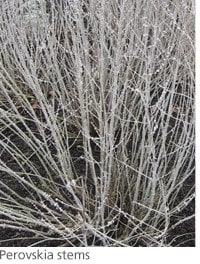 One of the best winter silhouettes, a silver-white upright collection of fine stems, is provided by Russian sage (Perovskia). In late-summer it’s covered with blue spires of flower, but in winter the white stems remain to form a wide witches’ broom that stands out well against the bare, brown earth. This silver-stemmed plant is hardy, even in the coldest gardens, and it seems to thrive in wet and dry summers alike because it’s found naturally in Afghanistan, Iran, Pakistan, and Tibet. One of the best winter silhouettes, a silver-white upright collection of fine stems, is provided by Russian sage (Perovskia). In late-summer it’s covered with blue spires of flower, but in winter the white stems remain to form a wide witches’ broom that stands out well against the bare, brown earth. This silver-stemmed plant is hardy, even in the coldest gardens, and it seems to thrive in wet and dry summers alike because it’s found naturally in Afghanistan, Iran, Pakistan, and Tibet.
Lavendins (labelled Lavandula x intermedia), santolinas and shrubby phlomis all persist through winter, before they are cut down in spring.
The pepperpot heads of Phlomis are very woody and last for many months. Many are sub-shrubs, but Phlomis tuberosa ‘Amazone’ is a lilac-pink perennial that dies away in winter to leave dark stems punctuated with occasional whorls of seed heads. It’s a Piet Oudolf favourite and flowers in the first half of summer yet still keeps a winter profile. It’s a useful aperitif in the prairie-border, most of which is much later into flower.
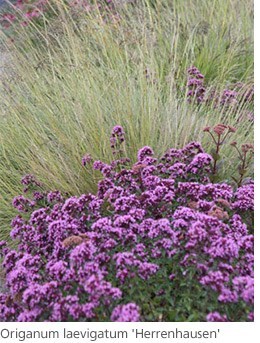 Origanum laevigatum comes in many forms, some rather floppy. However ‘Herrenhausen’ has wiry stems, dark rosettes of foliage and two-tone pink and purple flowers that turn blacker and blacker, getting lacier as the temperatures fall. This black-lace seed head is a stunner among silvers that might include the silver-green fingered leaves of Artemisia ludoviciana 'Valerie Finnis'. Origanum laevigatum comes in many forms, some rather floppy. However ‘Herrenhausen’ has wiry stems, dark rosettes of foliage and two-tone pink and purple flowers that turn blacker and blacker, getting lacier as the temperatures fall. This black-lace seed head is a stunner among silvers that might include the silver-green fingered leaves of Artemisia ludoviciana 'Valerie Finnis'.
Touches of Red
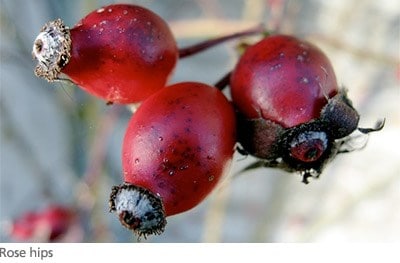
Rose hips can provide the cherry on the cake, although they vary from red, to soft-orange to cocoa brown. The large species rose Rosa glauca needs space, but by August it has produced round hips that age to orange-red, glowing against sooty grey foliage. Seed-eating birds adore this rose and seedlings will appear and be gratefully received by friends. Other notable rose-hip producers include the pink and white flowered rambler ‘Francis E. Lester and Rosa rugosa ‘Alba’, although all single-flowered roses will tend to set hips.
Add some of these and you can make your garden shine throught the year, providing daily enjoyment. |
Five things to do
 |
Plant a clematis
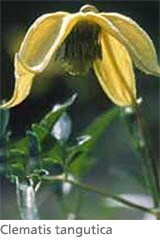
Plant Clematis tangutica if you have enough room. Known as the orange-peel clematis, due to the thick petals that resemble orange peel in texture, this produces lavish silver seed-head ‘spiders' in late-summer and autumn. In smaller gardens you can cut it back hard if you wish, but once established don’t cut it back too much if you want it to sprawl. September is a good month for planting all clematis: it gives them time to form roots whilst the soil is still warm.
|
 |
Summer-prune fruit

There's just time to summer prune top fruit like apples and pears. Reduce the side shoots on the main stems back to four or five leaves to promote more fruit buds. Leave the leading stems intact until winter. By then the sap will have stopped running and it will be possible to take back the leaders and thin them (if needed) before the sap begins to run. The same technique, cutting back side shoots, also suits redcurrants and gooseberries because both fruit on old wood.
|
 |
Lift potatoes
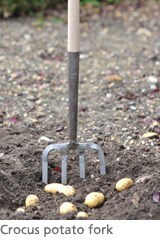
Make a mental note to get all your potatoes up before the end of the month, before slug damage ruins your crop. Write down the names of varieties you like.
|
 |
Order spring bulbs

Order your bulbs now and begin planting everything except your tulips. These are planted in cooler weather, to discourage tulip fire (Botrytis tulipae). Tidy any areas of the garden where bulbs already thrive, or are about to be planted.
|
 |
Start overwintering
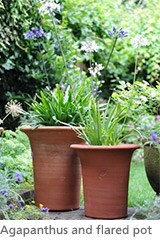
If you have agapanthus, cannas or similar in containers ease off watering and feeding them towards the end of this month. This will allow the foliage to toughen up and signal the end of the growing season. If you’re forced to store lilies or agapanthus pots outside, put them up against the wall and turn them on their sides to prevent winter waterlogging. |
|
|
Essential Kit for September
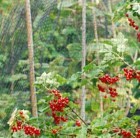
Fruit cage net
from £24.99
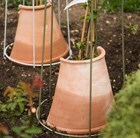
Clematis root protector
£19.99

Maxi fleece frost covers
from £8.99
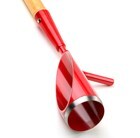
Long handled bulb planter
£17.99

Rootgrow
£9.99 £8.99

Bulb starter
£6.99 £5.99

Felco No.2
£57.99 £53.99
|
|











 Origanum laevigatum
Origanum laevigatum












